A few days back, the Idaho spring rains subsided just long enough for some hill intervals and skill work. This is an uncut POV from the “recovery” back down. Enjoy!
Music: Racecar, D is the new C
A few days back, the Idaho spring rains subsided just long enough for some hill intervals and skill work. This is an uncut POV from the “recovery” back down. Enjoy!
Music: Racecar, D is the new C
I’m proud to announce that I’ve again signed with First Endurance Supplements & Sports Nutrition Products for 2016! First Endurance’s line of products has helped to take my racing and training to another level in 2015. In addition to again using the (Electrolyte Fuel System) EFS and Ultragen products, I’m looking forward to using additional PRO line products in 2016 to take my training and racing to the next level. Please click on any of the images below to learn more!
The EFS line of products previously freed me from the need to use awkward salt tablets. In 2015, I’ve used the EFS Pro product during heavy training and racing with success. It is mild in taste, and also mixes well in a bottle with EFS liquid shot to free me from carrying a flask on the mountain bike. In a nutshell: It just plain works so I can focus on the task at hand.
 The liquid (vs. gel) consistency of the EFS Liquid Shot makes it very easy to consume quickly, even during races at a very high/intense effort levels. It also conveniently mixes well with EFS Pro!
The liquid (vs. gel) consistency of the EFS Liquid Shot makes it very easy to consume quickly, even during races at a very high/intense effort levels. It also conveniently mixes well with EFS Pro! 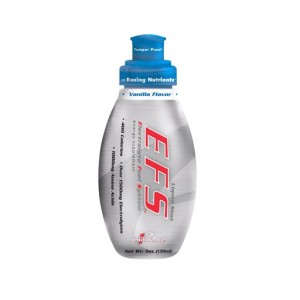 Ultragen Recovery Drink helps me to bounce back quickly from heavy and intense training load. In addition, I actually love the taste!
Ultragen Recovery Drink helps me to bounce back quickly from heavy and intense training load. In addition, I actually love the taste!
I’m very excited to be using the First Endurance MultiV-PRO Endurance Vitamin. This product is a comprehensive multivitamin that’s designed to meet the unique requirements of professional endurance athletes.
I’m excited to use the OptygenHP product this year during periods of high stress. “OptygenHP is clinically proven to increase VO2Max, increase the body’s ability to adapt to high levels of physical stress, increase anaerobic threshold and reduce lactic acid.”
I plan to use the PreRace for a mental and cardiac jump-start for races and key workouts:
I’m grateful for the opportunity to build on my relationship First Endurance in 2016. They are a company that makes the highest quality products. Their commitment to research and product safety and quality is something I’m proud to represent as a professional athlete. First Endurance products allow me to simplify my race day nutrition. They also allow me to train better. I, in turn and grateful that they believe in me and support my career! That’s a partnership built for success!
It’s taken me a bit of time to recover from the XTERRA World Championships, both physically and mentally. The second half of my racing season had it’s challenges for sure. I wasn’t satisfied with my performances at the Mountain, European, and US Championships. But with five solid weeks of training available before the World Championships, I was looking for a good result. I know that I get fit training consistently at home, sans travel. And everything went well in that five weeks. Very well I’d say. I was down to a good race weight for Maui. My power was back up to Springtime values, all systems were go.
But while some people were having the race they dreamed of, I was living a bit of a nightmare. If you’re interested in learning about things like hypervolemic hypernatremia, feel free to read on or just give a quick listen!
I flew over to Maui on the Tuesday before the race. Racing on Sunday, I figured this was enough time to finish my heat acclimatization. I know that when I travel, I typically don’t have issues with heat and humidity. HOWEVER, I do have issues with water retention. And for some reason, it causes compartment syndrome in my legs when I run and ride after flying. It typically takes 2-3 days to completely disappear, it usually does, and it did by Thursday. My best guess from reading a ton of literature is that my body is used to a certain amount of sweating. I’m not a salty sweater to begin with, so I must accumulate salt and then hold water during periods of forced inactivity. I’ve confirmed this with weight measurements.
This is usually not a big issue. But the cramping suddenly came back on an easy spin on Friday morning. It persisted on Saturday. I tried to drink lots of water, but I know from experience that it takes 2-3 days for my body to come back to equilibrium.
Not 24hrs.
So on race morning, I was hopeful that I could dilute my system and hope that some pressure would come out of my muscle fascia and allow me to put together the race I had worked so hard to prepare for. Warming up on the bike ride into the race site at Ritz Carlton Kapalua, I was feeling optimistic! No cramping in my glues or piriformis muscles. So far, so good. Well, the Ritz is not bike friendly (very odd place to have a triathlon world championships, don’t you think?) so I dismounted and walked to the transition.
On the downhill walk, my quads started to cramp painfully. Right up the middle (vastus lateralis/intermedius), top to bottom. I know it doesn’t do a damn thing, but I stopped to stretch it out. And it didn’t to anything. So now I was frustrated. But I stayed positive and focused on the race and doing what I could. I set up my transition. I drank a bottle of water. I decided to go sweat it out a bit longer on the bike. I cramped painfully during that ride too. Not good.
Needless to say I wasn’t a happy camper, but on the beach before the race I was all smiles and focused on the race. A switched flipped. There was a moment that I said to myself: control what you can, let everything else go. You trained hard for this, so just race. In that moment, I decided that I was going to race hard regardless of what happens.
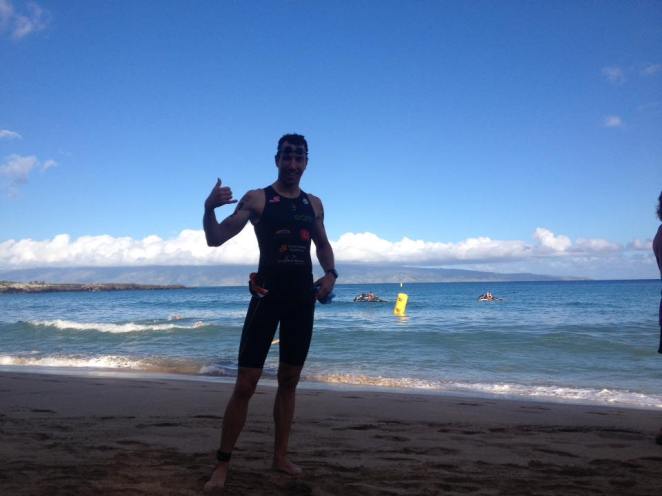 Now, I’ve been to Kona a few times. I have to say, the start of the XTERRA Worlds is much more exciting. It’s an ITU style start with a mix of XTERRA, ITU and Ironman’s best all standing shoulder to shoulder and ready to rip into beach break. All this while a helicopter flies panning shot maneuvers at like 30 feet away. It’s freaking electric!
Now, I’ve been to Kona a few times. I have to say, the start of the XTERRA Worlds is much more exciting. It’s an ITU style start with a mix of XTERRA, ITU and Ironman’s best all standing shoulder to shoulder and ready to rip into beach break. All this while a helicopter flies panning shot maneuvers at like 30 feet away. It’s freaking electric!
The horn went off and I sprinted into the water, missing the first drop off and sort of half-bellyflopped into the water. Despite my crappy hole-shot, the swim was uneventful for the most part, and I felt very fit running into transition. I got out fast, although I put my shoes on in T1, so my time doesn’t look special. and was ready to see what I could do on the bike. I pushed a bit out of transition and my legs were holding up. I sat down to start the long first ascent and calmed myself down. I was holding close to 500 watts, so I backed off knowing what I was able to sustain in the long term. I felt really, really powerful. And now optimistic!
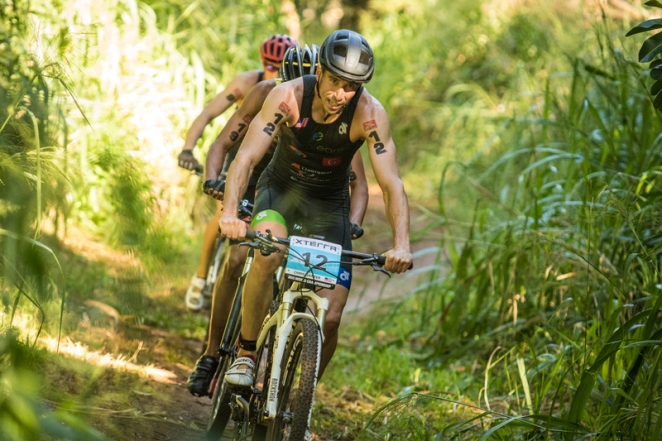
Just starting to fight the cramping, by sitting upright.
But about a half mile in, the cramping started up. I tried to kind of ignore it and focus on the race. But the pain quickly grew and grew until I was wincing and losing power. I let a few riders pass, then a few more. The pain became so unbearable that I couldn’t ride. Have you ever had that nightmare where something is chasing you, and you can’t run? I certainly have, although I’m usually not being chased by anything… but that’s EXACTLY how I felt. I ride all the time, but right now I just physically can not do it.
I did what I could to relax my muscles, stretch them out, stretch the opposing muscle groups, breathe, pray, whatever! I drank my whole fresh water bottle in one go. I was ready to bag it right then, since I know it doesn’t usually loosen up. But what if it did? I’d never know if I didn’t try. And there’s like 18.5 more miles to go! So I got back on and rode.
But it hurt.
A lot.
I could only ride standing up. So I did that. I rode standing up the whole time. Hips forward, knees splayed out to the side like I just learned to ride a bike today. Grunting in pain all the while. Periodically, to my surprise, the pain subsided. I rode like a man possessed and passed lots of people. Then it came back and I was standing on the side of the trail again. This happened three times over 11 miles of hard climbing and descending. The only explanation I can find is that the pain was so bad that my body decided to turn it off for a bit.
I can handle normal adversity. In fact, I crashed along the fence line exactly where Josiah (and many others) crashed. I just got back up and kept riding. Yeah, I was frustrated that in addition to my body not working, I had crashed. But crashing is part of racing. It’s the “body not working” part I can’t handle. And I really mean “not working”. I couldn’t sit. I couldn’t lift my knees. I physically had no business being on a bicycle. That’s a frustrating place to be, and it takes a toll on an athlete mentally just watching what you trained for go down the trail, and ultimately down the drain on that particular day.
Eventually, on the long descent in the eleventh mile, I realized that I was doing significant damage to my muscles. I was in constant pain and now couldn’t use my legs to absorb the terrain at high speed. So I had to slow down. Now the top AG men were coming past me at high speed. It was just getting dangerous for both my muscles and my well being. After much hemming and hawing along the trail, I pulled the plug.
It’s not a short ride back from mile 11. It was a painful ride on the highway back to Kapalua. My mind wandered from wanting to mourn my race, to just letting it go. I honestly wanted to cry at some points. We each put so much work into what we do. No one may see that work, but it gets done come hell or high water. And normally, what you have to show for it is performances. I’m there to race and I want to race hard. So not being able to even finish was a real bummer.
But it’s not the end of the world. I know this. I had a bad day. Time to hold steady until I get the chance to do it again. And that time will come soon enough. And I’ll be stronger when I get there. So, I wanted to put this race behind me pretty quickly. (Probably too quickly, since I didn’t want to think about racing, or even write a race report.) It just took some time to digest and come to a good place before I could.
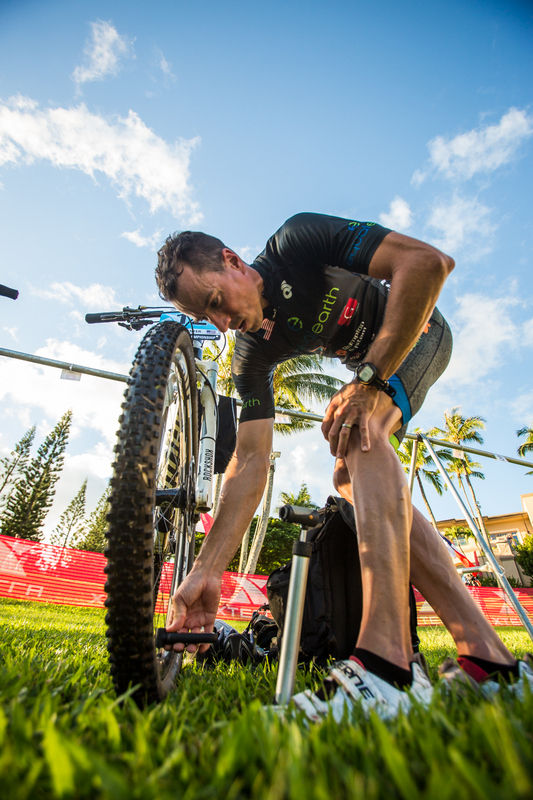
The thing I’m nervous about is putting measures in place so that the cramping issue does not return. There are a few tacks to take. One could say, well just watch your salt intake and weigh yourself to maintain correct hydration for the travel and week before the race. That’s the one I think will work. Watch what you eat, and weigh yourself to make hydration adjustments if needed. Or you could say, just go there earlier and give yourself more time. But I honestly think that wouldn’t do it. Mainly, because I’ve performed without cramping in hot humid weather before. I’ve done it this year in Alabama and Richmond. Not to forget that I used to run cross country in Hawaii. And also, I was there six days out. The issue went away, and then came roaring back with poor food choices.
The cause of my cramping is clear to me. Believe me, if it were a simple deficiency of electrolytes, as everyone is quick to offer up, I would be able to take care of it. I learned that 20 years ago. I know a lot about hyporvolemic hypernatremia (not drinking enough during exercise) and hypervolemic hyponatremia (drinking too much water without enough electrolytes.) I assure you, my issue is the one that falls though the cracks in medical literature, save for a few side-note mentions and papers on ICU patients during heart attack treatment.
How do I know? Data. The same cramping happened in the past, as recently as February when I was sick and drinking pedialyte to “stay hydrated”. I gained liquid weight and cramped. It took a lot of time for my body to get back. Dilution was the solution. And sweating. It’s very hard to believe (for me at least) but I weighed 11 pounds more in the days after this race than I did on race week. It’s nearly impossible to gain that much actual weight in a week. That’s like 40,000 calories of food in terms of body fat storage, or nearly 7,000 excess calories per day. I eat 3500, and my basal is over 1,750.
It was liquid. Here’s a picture of me a few days after the race:
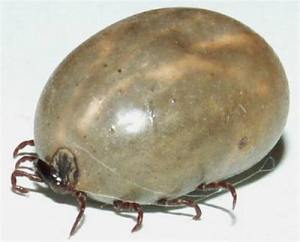
I found that this is something called hypervolemic hypernatremia. (Too much extracellular fluid caused by too much electrolyte). High blood plasma volume for an endurance racer is usually desirable. But In my case, there is a tipping point where it causes/caused compartment syndrome. My cramping symptoms are exactly what someone with compartment syndrome experiences: painful cramping in their most trained muscles, when they call on them. Especially brought on by eccentric contractions. This is why it comes on when I run/walk down hill, and also why it affects my glues when I’m riding since I have very tight psoae. or psoas…es? j/k. Anyway, that makes sense. I just don’t know the exact mechanism for the cramping, but it’s probably not crucial.
Most likely cause of too much salt? Island food basically. Tuna poke (poh-kay) and Teriyaki chicken are some of my favorite foods of all time. Poke basically marinated raw fish. As it happens, Hawaii is the Poke mecca. So, basically my salt intake doubled (or perhaps tripled) by eating poke as a snack and on my salads for lunch. Combine that with the fact that there’s pretty much teriyaki everything on the island + hot weather + reduced training load + salt water ingestion during swimming… and you have a perfect storm for super high blood plasma volume.
The good news? These are mostly controllable variables. I’ll be sure to focus on my race week nutrition an hydration next year and all of next season.
The thing I’m really excited about was my physical preparation for this particular race. This year, I feel like my coach and I really nailed the physical prep. I still think that the course in maui is not quite technical enough to be fair to the Xterra pros. But, I’m now more optimistic about my prospects of racing well on that course. In those brief instances when my body did decide to let me race, I was climbing much better than I ever have on that course. I could really push and keep pushing. Same as in training. It’s a shame that I didn’t get to unleash. I really wanted to see what I could do on that course. But I’ll get more chances.
Failure isn’t part of the process, it is the process.
I loved the race report posted by the eventual winner Josiah Middaugh. “If first you don’t succeed, try 14 more times.” In his explanation of the journey to his world title, he points out that it’s a long road and a myriad of things go wrong along the way. This is poignant reminder that things don’t always go as planned. All we can do is keep working diligently, and be the best people we can be along the way. This is very much in line with Coach Paulo’s “philosophy” (hehe) of working hard every day to be better. After all, that line of thinking has me performing the best level of my career. This year was my best season of racing so far. Two podium finishes at XTERRA “majors” and the Professional Tour Standings? Hell yeah! That gets me pumped for 2016. I’m looking forward to continuing to do things better in the future.
On that very optimistic note… that’s a wrap on the 2015 season’s racing.
Thanks as always to my family, friends and sponsors for supporting what I do. Equal Earth, Blueseventy, Champion System, 1st Endurance, G-Fit Studio Boise, TriTown Boise.
See y’all in 2016! Yeew!!!
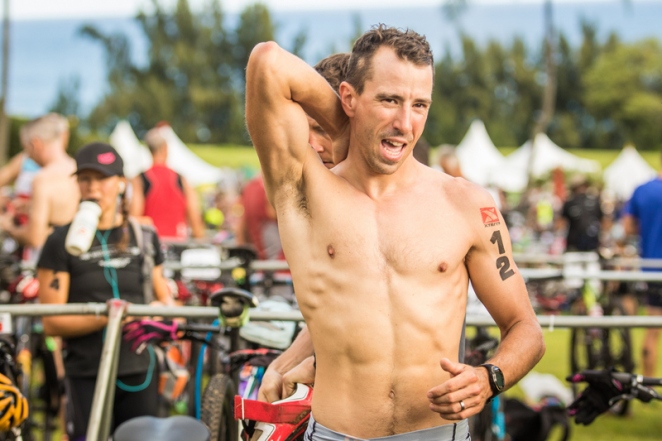
Let me just leave you with this gem.
I was going to write a “season summary” blog post, but I decided to let R. Buckminster Fuller explain how it went, and how I plan to pull it together for Worlds.
(An XTERRA Mountain Championships Race Report)
I have diverse interests.
I’m a scientist. But I’m also an artist. I like physics. But I like to make pottery. I like to work scientific with instruments. But I also I like to play musical instruments.
So I have a healthy inner conflict about data.
And what makes me an artist, surfer, musician, should naturally makes me ambivalent about data. In fact, I don’t like “paralysis by analysis”. There are just so many things in life that can’t be boiled down to numbers. Regardless, I generally like data. I was trained as an Analytical Chemist. So I’ve generated mountains of data in the lab. I’ve used it to help make millions of dollars worth of decisions. Data helps me come to conclusions and make important decisions.
Luckily, instead of generating “mountains of data” I now I generate “data on mountains”!
I’ll get to the data later, but this brings me to this month’s XTERRA Mountain Championships at Beaver Creek, Colorado.
Basically, I had a bad race.
I’ve bitched and moaned before about my woes of racing at higher altitudes. But last year, I had an “outlier” performance (to use a light data term.) In an attempt to gain some more points in the US Points Series, I trained right through the Mountain Championships and ended up walking away with my best placement of the year. In fact, it was my first pro paycheck! So, understandably, despite knowing that I don’t perform at my best at higher altitudes, I was OK with going back.
This year though, I had two 3rd place finishes and a 4th coming into Colorado. The US Points Series only takes your best 3 of 4 Regional Championship races (West, SE, East, Mountain) and the US Championship. So from a purely points-series standpoint, I didn’t even have to race. But, as a Professional, the real goal is to make money. And I feel like I belong racing the guys at the front. So I decided to race. It wasn’t even a question.
However, the lead-up to this race was not ideal. We had record temperatures in Boise (109F, 43C), so I took an impromptu trip to San Diego to escape. If you know me, I don’t travel all that well and my fitness is highly dependent on my ability to put in uninterrupted training. Also, I committed to trying to do 2 weeks at higher altitude ahead of the race, which took me up to Sun Valley at 6,000′, back to Boise at 2,700′ and out to Colorado. When I got to Colorado, turns out I lost my housing. So I had to scramble to find places to sleep. First air bnb, then at a friend’s new home at almost 9,000′ above sea level (OUCH) and then at a homestay. I developed bad altitude sickness while at 9,000′ and really never recovered until a few days after arriving home in Boise.
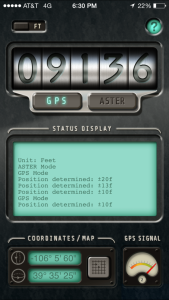
All in all, I took an expensive, lonely, and frustrating sight-seeing trip to Colorado and felt sick the whole time. I did get to connect with some great people. But I owe pretty much everyone an apology because I was feeling miserable. My body was all kinds of confused, screwed up or feeling sick for about three weeks straight.
In the last two days before the race though, I was finally settled in at a homestay around 6,000′ elevation. My body started to feel a bit better and even perform better. So despite still feeling a bit sick, I was now optimistic. On race morning, my legs felt good on my warmups. I felt I had weathered the storm so-to-speak and was thinking I was ready mentally to “giv’er” and have a ripper of a race.
The swim at the XTERRA Mountain Championships was reversed this year, swimming counter-clockwise around Nottingham Lake at over 7,000′ elevation. The start was cramped and I was relegated to the 2nd line. …not where I wanted to be. Still, I got out strong and settled into race rhythm a bit early knowing high altitude is not where you want to over-bake a swim start. Once in rhythm, I accidentally started pulling to the right a bit, caused by putting my head low to get my hips up. It popped me off the back of my pack and I had to correct before the 1st buoy. I put more power into every stroke after the buoy and found myself on Chris Foster’s feet with someone just beyond him.

Copyright: XTERRA 2015
I felt like we weren’t swimming fast/hard enough so I made multiple attempts to pass, but once out of the draft I didn’t have enough sustained power to get around. After trying to pass a few more times at buoys, I felt like the best strategy was to just keep swimming as efficiently as I could. I sat on with these two swimmers and prepared to destroy the bike leg to get as deep into the race as possible.
After two laps, we hit the beach and I noticed it was Ryan Ignatz with Chris and I. I was pretty stoked at this point since Ryan is from Boulder and had out-swam me by a significant margin in past years here. Progress. The three of us came out of T1 simultaneously. Unfortunately for me, I forgot to secure my cycling shoes to my crank and they flopped all around erratically as I tried to mount. With the uphill grass mounting area, I lost momentum and had to dismount and run a bit as Ryan and Chris rolled away.
I quickly got going and pushed hard with my feet out of the shoes to catch back up. I got back to Chris and put my shoes on at full speed. Ryan had about a 20 yard gap on us by the time we started to climb. I remembered how last year on the early part of the climb, I felt very good. This year I was sucking wind. My breathing was audible as I pushed hard to get to Ryan. I passed Chris and another athlete, and then Chris Legh.
Soon after, however, Chris Foster and the other athlete re-passed me. The gap to Ryan was not growing, so I settled in behind these two on the early part of the climb. According to my bike computer, the course climbs steadily for 1,900′ total, from 7,100′ to 9,000′ elevation. So basically, it’s a big-ass climb where you get significantly less oxygen as you go. 🙂
It’s not a technical climb at all. It’s a fitness test. And speaking of fitness, I was impressed with Chris Foster’s preparation. He was climbing very well. He asked if I wanted to pass him and I just told him that if/when I can, I will. I was struggling to get enough air.
But about 15-20 minutes into the climb, my breathing relaxed a bit and my legs started to feel better. I passed the two riders in front of me and pulled away steadily. I was excited that my body seemed to start working suddenly. There was hope that I could make some headway! Turns out, I didn’t catch anyone but Brendan Rakita, who unfortunately had suffered a flat.
In fact, despite “feeling” better, my power was the same on the first half and last half of the climb. This is just more confirmation that the way I feel and the way I perform are two separate things. Nevertheless, I “felt” good and was racing hard. I came into T2 in 8th place, disappointed but ready to put in a run into the money.
That is, until I started running…

Last year, my run performance was propped up by the fact that the run was reversed. There was a lot of running on long, shallow climbs broken up by short, steep descents. For me, this is a recipe for fast running at altitude. I can just get into a rhythm and suffer at a sustainable level, using my efficiency for speed. However, like two years ago, the course was clockwise this time. This meant brutally steep hills and shallow descents. The shallow descents are a minor issue. I’m not as efficient running down hill as I am on flats and moderate climbs. But steep climbs just take lots of power and high VO2 max. Unfortunately, it proved too much for me this year. I ran my body into such oxygen debt that I got light headed and fell. I actually fell off the trail on a straightaway trying to “recover” from the uphill efforts.
To add insult to this, for the first time in two years I was reduced to a shuffle at points. And it wasn’t by choice. My body shut down. My mind got cloudy. Alarm bells went off.
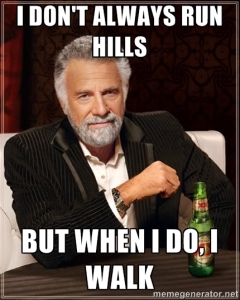
Now, I’m a decent runner. I also consider myself mentally tough. E.g., I came off the bike in 7th place one month earlier at XTERRA East Championships. There, I ran into 4th place in oppressive heat and humidity, with the fastest run of the day.
And despite not being able to stay upright or think straight, I pushed myself to run. And when Chris Legh caught me on a downhill, my instinct was to get on his shoulder. To show him I’m not going anywhere without a fight. But reality hit hard when we started going up a steep jeep road. I popped again and he ran away. It was a long and mentally painful run to the top of the 2nd climb and stumbling back down the mountain to the finish.
I’m not sure I’m happy with how I handled my poor performance. This was the first time in a race this season that I was truly unhappy with my performance as it was happening. I physically couldn’t run as fast as I wanted and needed to. Unfortunately, looking back I think it showed in my attitude. And for that I’m not proud. At the finish line someone said “great performance!” and I said something to the effect of “No, it wasn’t”.

Which was technically true. However, I should have just said “thanks”. So if that was anyone reading this, I apologize. I’m going through a learning curve. Just like learning to finish well gracefully, I have to learn how to take a lickin’ gracefully as well. So I’m taking away that I need to just put my emotions aside a bit and realize that we don’t always “knock it out of the park”.
I ended up getting 9th overall, 9th pro. Results can be found here.
No paycheck. Lots of travel bills, and three weeks of time invested, two of which at high altitudes.
When looking at my performance vs. 2015, I simply had a bad race. Compared to myself and compared to the competition, I swam about the same (maybe a bit better that the preceding year), but then I rode poorly, and then ran even worse. Ugh!
I’ve got a lot of work to do to right that ship. But I don’t think it was my overall fitness at play in Colorado this year. It was a less-than-perfect preparation. I’m going to need to stay in a good rhythm of training going into the next stop of the XTERRA US Tour when we hit the US Championship in Ogden Utah on September 19th if I want better results.
I’ve heard it mentioned a few times that this course is a good analog for the Nationals in Ogden, Utah. I don’t completely agree. For one, the run course at Ogden is at 6,000′. That’s high up, but it’s lower than even the swim in Colorado. The run has a few short pitches, but it doesn’t have two massive 2-mile steep climbs.
Also, the bike course is significantly different in a few ways. Not only does it start and end at altitudes (4,500′ and ends at 6,000′) both lower than the lowest point on the Beaver Creek course, but it’s comprised of two distinct climbs. The lower climb is gradual, with a technical descent afterwards. The top climb is slightly steeper and tops out at 6,500′ before a long descent to T2. Still lower than the swim in Beaver Creek. So no, they’re not similar courses. People from more moderate altitudes can actually compete with Coloradans there. I don’t get altitude sickness in Ogden which sits at 4,000′, so that’s a start right there. Living at high altitude is an advantage that many people can’t afford. I’m fortunate that Boise sits at a modest altitude while having a low cost of living. This lets me have a good quality of life, while building good fitness on awesome terrain.
Speaking of fitness… an interesting insight into my current fitness was an uphill time trial I did 5 days after the race in Colorado. I climbed the aptly named “Hard Guy” trail here in Boise at TT effort. (For reference, this was my third workout of the day, so I was not at all “fresh” just as in Colorado) But I used the exact same everything in terms of equipment and nutrition. Unlike Utah, the Hard Guy climb is a good analogy for the climb in Beaver Creek. They are both about 4.4 miles with 1,900′ of continuous climbing. The biggest difference is that this one starts at 3,500′ and ends at 5,400′ elevation. (Beaver Creek climbs from 7,100′ to 9,000′ according to my altimeter) When you live at 2,700′, that’s significant difference. How significant? Well, I said I don’t mind data… so let’s look at some simple data:
Beaver Creek (July 18, 2015)
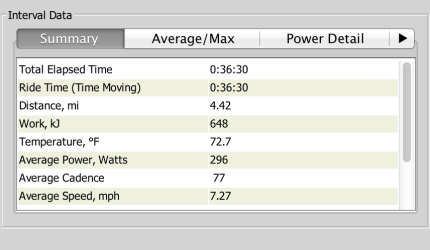
Hard Guy (July 23, 2015) 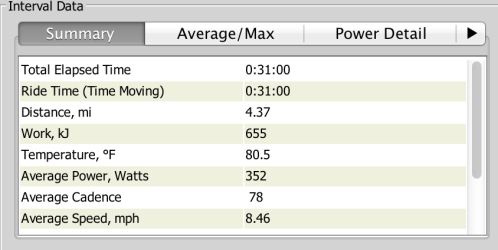
That’s a difference of 56 Watts average, and 1.2 mph on a VERY similar climb. To put it into perspective, (ignoring that I didn’t know where the segment actually started) I was about a minute off of Nico Lebrun’s KOM and half a minute off of Michael Tobin. Both XTERRA World Champions.

Now, that was when they were climbing with two other athletes. And I wasn’t there. So, I don’t know how hard (or not hard) they were going. All I have to go by is the data. And in a town of serious mountain bikers, no one has beaten those times. On the most popular climb. (The QOM is Kristin Armstrong, BTW)
But KOM’s and comparisons aside. I’m as fit as I’ve ever been in my life, and climbing well in Boise. And certainly better than I did at higher altitude five days earlier. And I have every reason to believe I’ll go faster in Utah than I ever have. I believe in hard work. I’ve been putting in very hard work on a consistent basis, all year long, and steadily getting better.
If only there were a way to tell if you were getting steadily better…
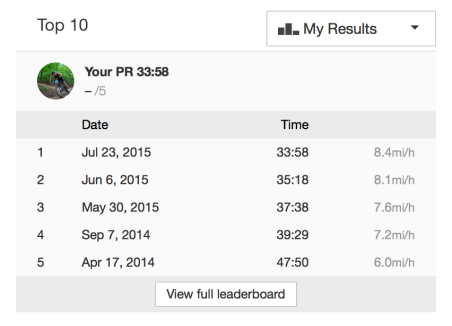
So Strava has it’s uses. (Downhill it’s kinda dangerous, uphill it’s proving fairly useful!) My recent fitness on this particular test piece was over a minute faster than the preceding month. Over three minutes faster than May, and over five minutes faster than my best effort last year.
#progress
But I’ve hit a slump in terms of results. It happens. I’ve watched other athletes go through the same thing for various reasons. It could caused by anything from too much air travel, to plain bad luck. And it will pass.
“Do what you ought, come what may”.
Right now, what has come is a slump and I’m continuing try my best to do what needs to be done, regardless.
When you hit a slump, it’s important to be thankful for those who see you through thick and thin and support what you do. I wouldn’t be in such a great position this year (3rd Overall in the XTERRA US Pro Tour) without the guidance of my coach Paulo Sousa. Also, I owe a HUGE thanks to my title sponsor Equal Earth. Thanks to my sponsors and supporters: Champion System, Blue Seventy, First Endurance, G-Fit Studio Boise and TriTown Boise for putting me in the best equipment to do my job!
Up next is XTERRA Portland on August 8th. If you’re in the Pacific Northwest, please come out and race! In addition to an awesome XTERRA, there’s also a MTB race and trail running races!